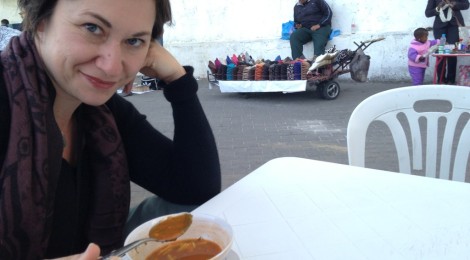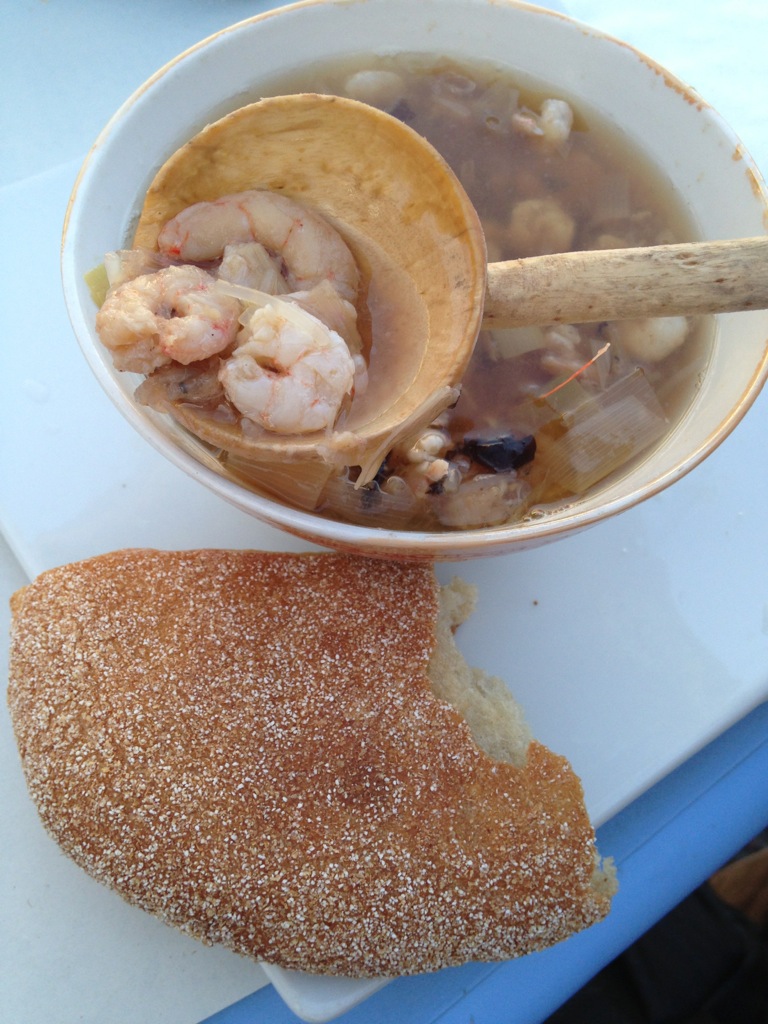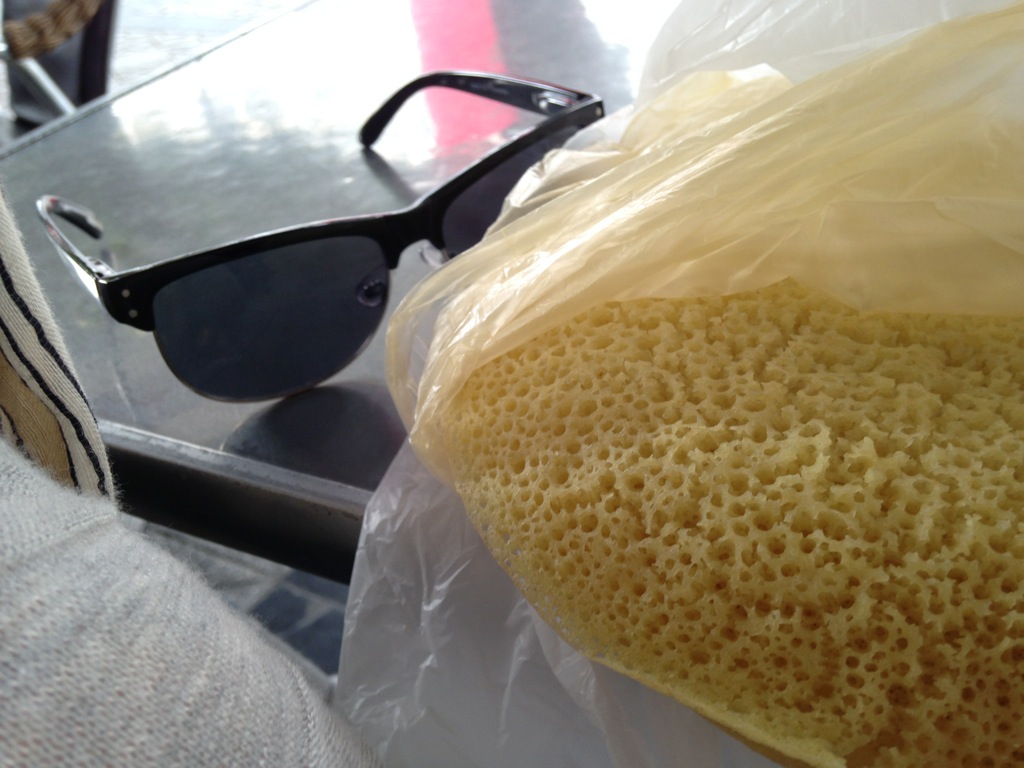
Spoons and a Crescent Moon: Soup In Morocco
The Sahara consumes part of Morocco, and while snow does fall in the Atlas and Rif mountains, the people of Morocco are water conscious.
Perhaps this water consciousness is why soup is such an important part of the Moroccan diet. Whatever the reason, we’ve embraced the tradition, enjoying a steaming bowl morning, noon, and night.

A stunningly delicious fish soup and the most common kind of soup bread–called hobz–on the docks in Casablanca.
We only found it in Fez, where it is only eaten for breakfast: bissara is a savory soup of fresh fava beans, thick enough to claim the status of porridge. We had ours on a cold, rainy morning in a market stall the size of three American bathtubs, shoulder to shoulder with a half-dozen locals and two soup servers. Will you have olive oil on yours? Sure! Cumin? Sure! Some of that peppery red powder? Sure! Wow! A little extra salt? Why not?
For the record, Moroccan soup is always served with bread. In the most budget-minded soup stalls we tried in Marrakech, bread was a one-dirham add-on to a three-dirahm meal, bringing your total supper bill to $0.50.
The spectrum of bread in Morocco is enormous. The most common type to accompany soup is a small, round, flat loaf whose diameter is a bit smaller than the spread of your hand. Sometimes we are each given a loaf, sometimes they cut a loaf in half and give us each half, cutting the next loaf in half once we’ve proven to be good soup and bread eaters.

Another kind of Moroccan bread–beghrir in Arabic, I think–was not served with any soup we ate. It’s lovely pancake though, and somewhat similar to Ethiopian enjira. Though yeasted, it isn’t a sourdough like enjira.

Msemen is another traditional Moroccan bread. Not absorptive enough for soup, it is often served for breakfast. This version in Marrakech was served with butter and honey. In Chefchouen, hot from the griddle, we had it spread with a soft white cheese.
Harira is the most common soup in Morocco, and every batch is a little different. How your mother made it surely plays an important role.
The components that make a recognizable harira? Lentils, tomato, a little bit of fine pasta, a little bit of meat (usually lamb), a thickened broth, parsely, cilantro, and everything diced fine.
Mother’s variations? We’ve had some with diced artichokes. Some have a strong lemon streak (One street chef in Fez served his with wedge of lemon.). Some are heavier on tomato. Richer ones will have more meat. Chickpeas sometimes make an appearance, though never in lieu of lentils.
I haven’t made this recipe, but looking it over, I think it should offer a good taste of what harira is like:
http://moroccanfood.about.com/od/soupsandappetizers/r/harira_recipe.htm
My suggestions? Use real turmeric. Use both parsely and cilantro. This recipie will be fine without smen (a fermented butter common to cooking in North Africa), and anyone outside Morocco who has a reliable source for smen should put a comment on this blog revealing their secret source.
Another point of note for all the Moroccan soups: they were all lighter on salt than I expected.
One notable evening soup we had was labeled as “Pumpkin Bissara” on the menu. We suspect it is an invention of Cafe Clock in Fez, and like everything we had a Cafe Clock–including camel burger, fresh mint lemonade, spiced coffee, and sheeba (wormwood) tea–was splendid. The squash of Morocco are small, green or tan and green on the outside, and a rich, dark orange on the inside that is like nothing I’ve ever seen in an American pumpkin. The soup was equally rich and dark in color, and was so thick the spoon nearly stood up on its own. Unsippable, but not a soup you needed to chew, either. That’s the nod to bissara, I suppose, the porridge-like texture.

Pumpkin bissara at Cafe Clock. Alongside is the fresh mint lemonade and some dainty wedges of bread. Atop are three deeply roasted and delicious ‘pumpkin’ seeds.
The flavor? Sweet from the squash, yes, and spiced, but not like a pumpkin pie. Black pepper and red pepper. Certainly the soup was not fortified with cream. Onion. It was noted on the menu as vegan on the menu (a rare thing in Morocco, I assure you) so how they achieved the rich depth of flavor remains a mystery. There was a secondary vegetable—arichokes?—but it was a member of the supporting cast and the puree was too fine to differentiate by appearance. Though a dark, earthy flavor, there was a balance among the flavors that I now think is a hallmark of Moroccan cooking.
Eating alongside the Moroccans who live on a budget,
Chris

You _had_ to write a blog post entirely about soup!
As you may have heard, I am somewhat partial to soup.
I fear I’m headed to Morocco at some point in my life!
T